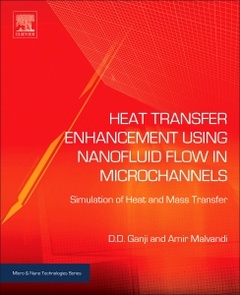Description
Heat Transfer Enhancement Using Nanofluid Flow in Microchannels
Simulation of Heat and Mass Transfer
Micro and Nano Technologies Series
Authors: Ganji Davood Domairry, Malvandi Amir
Language: English
Subjects for Heat Transfer Enhancement Using Nanofluid Flow in...:
Keywords
Active techniques; Brownian motion; Buongiorno model; Channel; Channels; Energy; External forces; Flow; Fully developed; Heat transfer enhancement; Heat transfer rate; Heat transfer; Magnetic field; Microchannel; Modified Buongiorno's model; Nanofluid; Nanoparticle migration; Nanoparticles; Navier-Stokes equation; Passive techniques; Power; Pressure drop; Simulation; Theoretical modeling; Thermophoresis
143.27 €
In Print (Delivery period: 14 days).
Add to cartSupport: Print on demand
Description
/li>Contents
/li>Readership
/li>Biography
/li>Comment
/li>
Heat Transfer Enhancement Using Nanofluid Flow in Microchannels: Simulation of Heat and Mass Transfer focuses on the numerical simulation of passive techniques, and also covers the applications of external forces on heat transfer enhancement of nanofluids in microchannels.
Economic and environmental incentives have increased efforts to reduce energy consumption. Heat transfer enhancement, augmentation, or intensification are the terms that many scientists employ in their efforts in energy consumption reduction. These can be divided into (a) active techniques which require external forces such as magnetic force, and (b) passive techniques which do not require external forces, including geometry refinement and fluid additives.
1. Introduction to Heat Transfer Enhancement Techniques2. Heat Transfer and Pressure Drop in Channels 3. Preparation and Theoretical Modelling of Nanofluids4. Mass Transfer in Channels5. Simulation of Nanofluids flow in Channels 6. External Forces Effect on Intensification of Heat Transfer
Materials scientists, chemical engineers, chemists and physicists seeking to improve the heat transfer rate in small-scale systems with nanoparticle inclusion
Amir Malvandi is working as an associate researcher at Sun & Air research institute (SARI) in Ferdowsi university of Mashhad, Iran. He Received his B.S. in mechanical engineering from this university in 2009 and graduated from Amirkabir University of Technology in 2012. His main areas of research are fluid flow and heat transfer in curved pipes, numerical study on the flow over bluff bodies, Homogeneous and non-Homogenous nanofluid and convective heat transfer.
- Gives readers the knowledge they need to be able to simulate nanofluids in a wide range of microchannels and optimise their heat transfer characteristics
- Contains real-life examples, mathematical procedures, numerical algorithms, and codes to allow readers to easily reproduce the methodologies covered, and to understand how they can be applied in practice
- Presents novel applications for heat exchange systems, such as entropy generation minimization and figures of merit, allowing readers to optimize the techniques they use
- Focuses on the numerical simulation of passive techniques, and also covers the applications of external forces on heat transfer enhancement of nanofluids in microchannels




